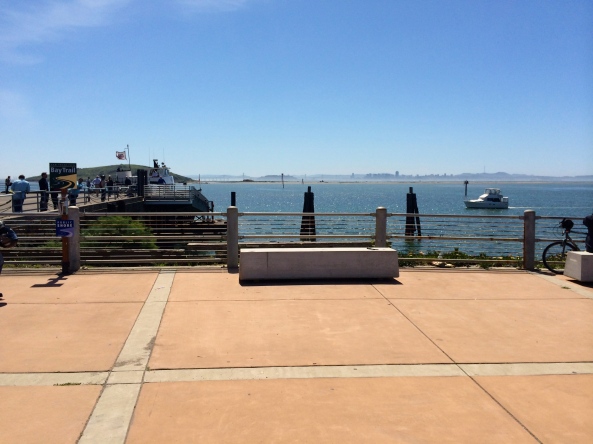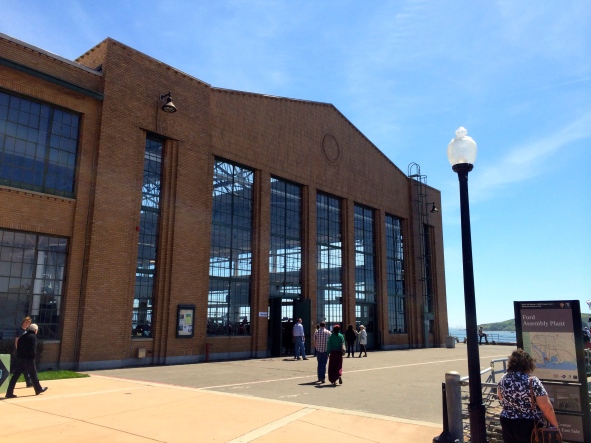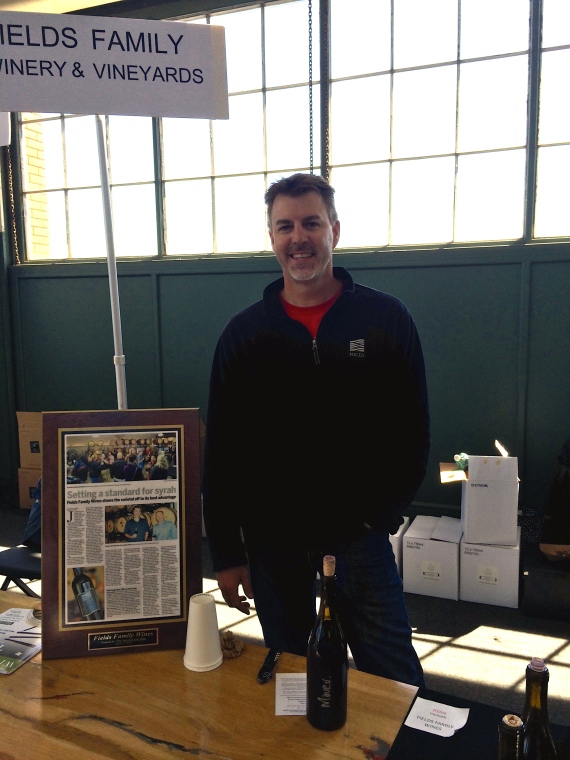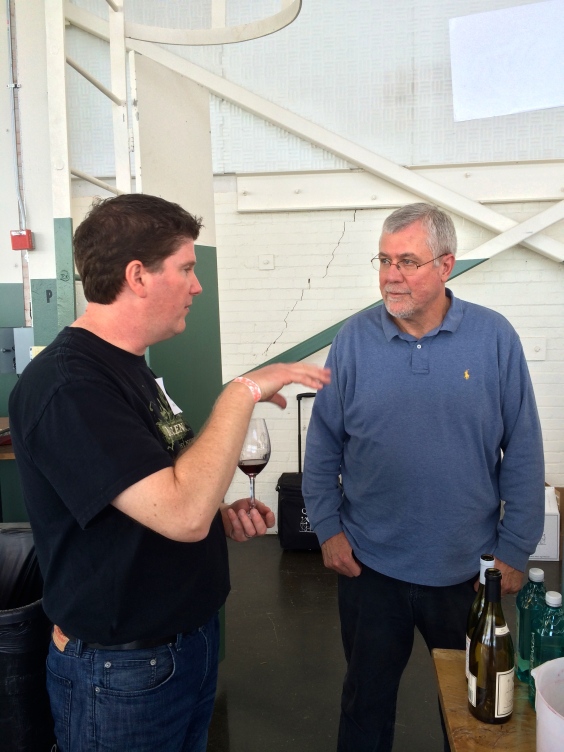The Rhone Rangers Grand Tasting is a huge event, with far too many wines for me to get through. While I chose to focus on Grenache, I thought it would be great to also get a sense of Syrah. I love Syrah – especially “cool-climate” style. So today, I’m thrilled to bring you some bonus coverage of the event by featuring Cyrus Limón (a.k.a. Mr. Syrah) from sólosyrah.
Syrah, especially “cool-climate” Syrah, is Cyrus’ thing, and I trust his palate.
Take it away Cy…
_________________________________________________________________________
By Cyrus Limón
The 2014 Rhone Rangers Bay Area Tasting: Spotlight on Syrah

Umm, yes, I’d like to taste some wine with this view.
The annual Bay Area Rhone Rangers tasting is a great way for me to get a sense of the state of Syrah in California. Although it’s usually missing some of my favorite Syrah producers like Peay, Arnot-Roberts, and Failla it still has a growing cadre of cool-climate Syrah aficionados that make it a great place to check in on Syrah. This year’s tasting was my favorite so far. The location at the Craneway Pavilion in Richmond was beautiful and the wineries were spread out well to allow for a lot of elbow room and a lot of face-to-face contact with winemakers. The crowd wasn’t too big (great for those of us there, but maybe not for the wineries) and although there were a few noticeably inebriated people there seemed to be less general drunkenness than in previous years.
The beautiful Craneway Pavilion in the Richmond Marina
It’s nice to have a plan when going into big events like this and for me the plan was to taste a lot of Syrah. I checked in with the handful of producers that are doing Syrah in the style I appreciate but was also keen to find some new producers doing a cooler-climate style.
Here’s a list and brief description of wines that I tasted at this year’s Rhone Rangers that most represent the lower alcohol, cooler climate style that I love some much. The wines below are organized by the order in which I tasted them.
Kieran Robinson Wines
I’ve written about this wine before but Kieran Robinson’s 2010 Bennett Valley Vivio Syrah is a great example of elegant Syrah. The wine has mid-palate lift and some great olive and red fruit aromas. The 2009 was a bigger wine from the same vineyard with more of a meaty chocolate profile. The ’11 just got bottled and will come in at about 13.3% ABV and the 2012 at 14.3% ABV. Kieran says that this type of vintage variation is common in Bennett Valley; you pick it when it’s ripe.
Terre Rouge
Terre Rouge in an old Syrah house that wasn’t on my radar until last year’s Rhone Rangers event. Bill Easton makes spectacular Syrahs from special spots in the Sierra Foothills and Lodi. His lower end wines tend to see less oak and are made for easier drinking with an emphasis on fruit and lower tannins. His higher end Syrahs are more tannic and see a lot more new oak and are meant to age.
The 2010 Les Cotes de l’Quest was actually my favorite from the tasting because of that judicious use of oak and had a bright and pure fruit profile.
The 2008 DTR Ranch is their estate wine and sees a little more new oak. The oak was mostly in check and the Syrah flavors came through nicely.
The 2008 Sentinel Oak was a much “bigger” wine with more tannins on the finish and more new oak. It’s still got great acidity though and I’m sure this is the kind of Syrah that could age for a long time (and already has) but for me I just would have liked to see the oak dialed back a tad.
The 2008 Ascent is that vintage’s example of their flagship wine. This wine spends 24 months in new oak. It had more of a blue fruit profile. I think this is a good wine for this style but again I think the new oak could be dialed back.
Although there’s no question in my mind that these are well-made Syrahs, my question is why not let the pure fruit aromas come through more on the higher end wines keeping the new oak in check?
Two Shepherds
I love checking in on William’s wines and this was one of the few wineries where I tasted through all the wines. The whites were tasting beautifully and William’s curent release of reds seemed even more cohesive at this juncture then the last time I tasted them.
William does have a yet-to-be-released 2012 Saralee’s Vineyard Syrah that he let me taste off to the side. I really like this Syrah (especially after the Terre Rouge wines) because it only sees neutral oak so it’s a great example of how a completely unadulterated Syrah picked at low alcohol levels can bring forth the true character of the varietal. This wine is young and had just been opened so it was full of mouth-filling acidity but also really delicious fresh fruit character. It’s an elegant Syrah that sets itself apart because of its core of acidity. I can’t wait to taste it in about 6 months to see how it continues to evolve in bottle.
Fields Family Wines
Going from William’s Syrah with it’s bracing acidity to Ryan Sherman’s easy-drinking Lodi Syrah was a study in contrast. I won’t go on too much about them here because I’ve only recently done a blog post on them but I do want to say again I am struck by how Ryan achieves fresh fruit character in his wines in Lodi. Yes they are riper styles of Syrah but these are not big vanilla and blue fruit Syrahs. His judicious use of oak, well-timed picking decisions and the cooler site along the Mokelumne River Valley allow the wines to maintain a true Syrah character.
The affable Ryan Sherman of Fields Family Winery
Donelan Wines
I hadn’t checked in with Donelan since Tyler Thomas had moved on (link) and it was nice to meet new winemaker Joe Nielsen. Most of the Donelan wines aren’t exactly cool-climate but I was struck by their judicious use of new oak and a nice core of acidity that carried through all the Syrahs.
The 2011 Cuvee Christine is Donelan’s blend from different vineyards and is meant to illustrate the potential for Syrah in Sonoma County. It’s a nice fresh style of Syrah. Not too complex and intensely food friendly.
The 2011 Walker Hill, which I’d had before, was also well done with nice fresh fruit elements and surprising acidity.
The 2011 Richards (which was being poured at small samples off to the side) also showed enjoyable Syrah savory aromas and freshness even after spending 30 months in barrel.
Clos Saron
It was a pleasure to spend some time with Gideon Beinstock at Clos Saron. He’s the type of person I think I could sit and talk to for hours and someday I hope to get a chance to do just that at his winery in the Sierra Foothills. If you want to learn a lot more about the Clos Saron project then you’ve got to check out this excellent podcast with Levi Dalton.
All of Gideon’s Syrahs were great but I did get a common thread in the aroma profile that was both perplexing and alluring. The closest I can come to describing it is that it was almost like the aroma of a root beer candy, maybe mixed with a tootsie roll. I asked Gideon if he got any common thread of aroma through all the Syrah and although he didn’t say yes he did say that it was possible. Gideon mentioned that it could be the native yeast from the winery and then he laughed and told me that possibly it was just his own stinky feet. (Gideon makes the wine in an old world style and still foot stomps the grapes.) Regardless of how that interesting aroma got in there it’s clear it’s become part of the “terrior” of the Syrah.
The 2011 Stone Soup Syrah and 2009 Heart of Stone both had great cool-climate profile with savory aromas and a nice acidic core. The 2005 Heat of Stone was a bit more extracted and a riper style which Gideon attributed to an over exuberance on his part at this time of his winemaking career to extract big fruit and flavor from the grapes. He now works the grapes less (less punchdowns, less maceration) to make his wines more elegant and less “new world” in profile.
MacLaren Wine Company
I also checked in with Steve Law to get a chance to taste one of my favorite Syrahs, the 2010 Judge Family Bennett Valley Syrah. I think Steve did a great job with this wine and I’m always impressed with it’s freshness and aromas of salted plum and olive. It’s always a treat to taste.
Qupé Winery
Now these were the wines of the tasting for me.
As I mentioned before, this year’s event was less overwhelming than the previous years and I was thrilled to see that there was some space at the Qupe table for me to actually talk with Bob Lindquist and fawn over his Syrahs. I’d recently had a corked Qupe and one that was hopelessly infected with Brettanomyces so I was thrilled to get a chance to wash away those bad experiences with what I was hoping was some great Syrah.
I started off with the 2011 Bien Nacido Vineyard and boy was it tasting good. Elegant, floral, peppery and bright with a well-structured mid palate this was a delicious example of a classic site for Syrah.
The next wine was an iteration of Qupe’s famed Sawyer Lindquist Vineyard. The 2011 Sawyer Lindquist “Sonnies” is an homage to Bob Lindquist’s mother and is a selection of the best blocks from the vineyard and the best barrels from those blocks. This wine was tasting spectacular. It had that perfect combination of cool-climate characteristics mixed with rich and delicious mid-palate and an elegant finish.
The 2011 X Block Bien Nacido was also floral and elegant and tasting very much in balance at this moment.
It was a happy moment for me to taste these wines and get to talk with Bob Lindquist to extoll the virtues of cool climate Syrah. At one point Steve Law came over from MacLaren and the three of us geeked out on French Syrah and how food-friendly it is.
Two generations of cool-climate Syrah lovers meet for the first time: Steve Law and Bob Lindquist
Lagier Meredith Vineyard
I love to check in with Stephen and Carole’s deliciously graceful Napa Syrah. This is a full wine but it’s light on it’s feet at the same time. The 2011 Syrah, Mount Veeder had a classic cool-climate Syrah black olive disposition with a full mid-palate. Again, this is a Syrah that shows that judicious use of oak and smart picking decisions can create an elegant Syrah in an area known for bigger wines.
Skylark Wine Company
I finished the day checking in with a relatively newer winery because I noticed that they had a Rodger’s Creek Syrah which is a cool-climate site near the Petaluma Gap and Carneros. The 2009 Rodgers Creek was a beautiful Syrah, peppery and bright with beautiful elegance. Another winery to get to know more and a style that I hope they stick with.
All in all, I’d say that there are more wineries attempting to make Syrah in a more floral, peppery, savory style; less blocky and big and overly brawny. Few wineries have gone all in on that style and some of my favorite Syrahs from the cooler vintages of 2010 and 2011 have climbed up in ripeness and alcohol level for 2012 and 2013 when the vintages were warmer so it’s hard to say if there’s really a stylistic shift or not. I’m heartened by many of my talks with winemakers who agree with me that Syrah doesn’t need to be jammy and oaky but then they admit that in order to please the general consumer they generally offer Syrahs that are bigger and riper to round out their portfolios. And maybe this is indeed the future of Syrah, that we just have to get comfortable with the fact that it comes in different styles and that consumers appreciate both styles.
As long as the cooler-climate styles stick around then I’m comfortable with that.
Here’s to Cool Climate Syrah – Rhône On Cyrus!
About Cyrus Limón: Is a wine enthusiast devoted to extolling the virtues of cool-climate Syrah. He’s relatively new to the “wine thang” as I refer to it, but he’s dived headlong into it the last few years. He started where virtually all wine enthusiasts start, with fruity wines. But his wine journey has lead him to perfect a palate for cool-climate Syrah. You can follow Cyrus on twitter @solosyrah



